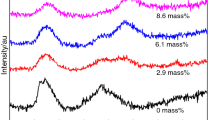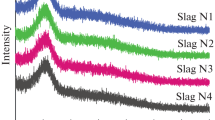Abstract
A rapidly air-cooled ladle furnace slag (RA-LFS), which is a type of steelmaking slag discharged from a steel mill, was used to synthesize CaCO3 film. The CaCO3 film with 35 cm2/of surface area was synthesized under atmospheric conditions, and the surface morphology of the CaCO3 films was changed by using additives (CaCl2 and ethylene glycol). Especially, the addition of CaCl2 changed the surface morphology of CaCO3 film with pore and induced new material properties, such as water adsorption. The (012) face of CaCO3 film (calcite) was rapidly decreased by the addition of CaCl2. The major components of RA-LFS were calcium (type of CaO, 53.9wt%) and aluminum (type of Al2O3, 37.9wt%), and the major crystal phases of RA-LFS were C3S, C12A7, and C3A. The calcium extraction efficiency of RA-LFS was significantly increased after the CaCO3 film synthesis. The material properties (hardness and elastic modulus) and the thermal characteristics of the CaCO3 films were analyzed by nano-indentation and thermogravimetry–differential thermal analysis. The synthesized CaCO3 films from RA-LFS and Ca(OH)2 (reagent) showed similarities in terms of their material properties and the decomposition temperature.
Similar content being viewed by others
References
Korea Environmental Industry & Technology Institute, High–efficiency recycling technology of steelmaking slag, Process Control Instrum. Technol., 4(2015), p. 168.
P.C. Chiang and S.Y. Pan, Carbon Dioxide Mineralization and Utilization, 1st ed. Springer Nature, Singapore, 2017, p. 233.
A. Sanna, M. Uibu, G. Caramanna, R. Kuusik, and M.M. Maroto–Valer, A review of mineral carbonation technologies to sequester CO2, Chem. Soc. Rev., 43(2014), p. 8049.
E.M. Gartner, J.F. Young, D.A. Damidot, and I. Jawed, Structure and Performance of Cements, 2nd ed., J. Bensted and P. Barnes, eds., Taylor & Francis, New York, 2002, p. 57.
W. Seifritz, CO2 disposal by means of silicates, Nature, 345(1990), No. 6275, p. 486.
W.J.J. Huijgen, G.J. Witkamp, and R.N.J. Comans, Mineral CO2 sequestration by steel slag carbonation, Environ. Sci. Technol., 39(2005), No. 24, p. 9676.
Y. Sun, M.S. Yao, J.P. Zhang, and G. Yang, Indirect CO2 mineral sequestration by steelmaking slag with NH4Cl as leaching solution, Chem. Eng. J., 173(2011), No. 2, p. 437.
A. Polettini, R. Pomi, and A. Stramazzo, Carbon sequestration through accelerated carbonation of BOF slag: Influence of particle size characteristics, Chem. Eng. J., 298(2016), p. 26.
M. Uibu, R. Kuusik, L. Andreas, and K. Kirsimäe, The CO2–binding by Ca–Mg–silicates in direct aqueous carbonation of oil shale ash and steel slag, Energy Procedia, 4(2011), p. 925.
G. Montes Hernandez, R. Pérez López, F. Renard, J.M. Nieto, and L. Charlet, Mineral sequestration of CO2 by aqueous carbonation of coal combustion fly–ash, J. Hazard. Mater., 161(2009), No. 2–3, p. 1347.
H. Jo, M.G. Lee, J. Park, and K.D. Jung, Preparation of high–purity nano–CaCO3 from steel slag, Energy, 112(2017), p. 884.
K. Song, K. Kim, J.H. Bang, S. Park, and C.W. Jeon, Polymorphs of pure calcium carbonate prepared by the mineral carbonation of flue gas desulfurization gypsum, Mater. Des., 83(2015), p. 308.
T. Thenepalli, A.Y. Jun, C. Han, C. Ramkrishna, and J.W. Ahn, A strategy of precipitated calcium carbonate filers for enhancing the mechanical properties of polypropylene polymers, Korean J. Chem. Eng., 32(2015), No. 6, p. 1009.
S.W. Lee, K.B. Lee, and S.B. Park,A new approach to the synthesis of functional thin films: Hierarchical synthesis of CaCO3 thin films and their transformation into patterned metal thin films, Micron, 40(2009), No. 7, p. 737.
K.B. Lee, S.B. Park, Y.N. Jang, and S.W. Lee, Morphological control of CaCO3 films with large area: Effect of additives and self–organization under atmospheric conditions, J. Colloid Interface Sci., 355(2011), p. 54.
S.W. Lee, G.T. Chae, M. Jo, and T. Kim, Comparison of Portland cement (KS and API class G) on cement carbonation for carbon storage, J. Mater. Civ. Eng., 27(2014), No. 1, art. No. 04014105.
W.C. Oliver and G.M. Pharr, An improved technique for determining hardness and elastic modulus using load and displacement sensing indentation experiments, J. Mater. Res., 7(1992), No. 6, p. 1564.
W. Kurdowski, Cement and Concrete Chemistry, 1st ed., Springer, New York, 2014, p. 138.
J.G.M. De Jong, H.N. Stein, and J.M. Stevels, Hydration of tricalcium silicate, J. Appl. Chem., 17(1967), No. 9, p. 246.
H. Cölfen, Precipitation of carbonates: recent progress in controlled production of complex shapes, Curr. Opin. Colloid Interface Sci., 8(2003), No. 1, p. 23.
S.R. Dickinson and K.M. McGrath, Aqueous precipitation of calcium carbonate modified by hydroxyl–containing compounds, Cryst. Growth Des., 4(2004), No. 6, p. 1411.
J.W. Mullin, Crystallization, 4th ed., Elsevier Butterworth–Heinemann, New York, 2004, p. 184.
S.W. Lee, Y.I. Kim, K. Lee, J.H. Bang, C.W. Jun, and Y.N. Jang, Effect of serine and arginine on the phase transition from amorphous CaCO3 and CaCO3·6H2O to calcite film, Mater. Trans., 53(2012), No. 10, p. 1732.
J.W. Xiao and S.H. Yang, Polymorphic and morphological selection of CaCO3 by magnesium–assisted mineralization in gelatin: Magnesium–rich spheres consisting of centrally aligned calcite nanorods and their good mechanical properties, CrystEngComm, 13(2011), No. 7, p. 2472.
S.W. Lee, Y.J. Kim, Y.H. Lee, H. Guim, and S.M. Han, Behavior and characteristics of amorphous calcium carbonate and calcite using CaCO3 film synthesis, Mater. Design, 112(2016), p. 367.
J.P. Andreassen, R. Beck, and M. Nergaard, Crystallisation–A Biological Perspective, Edited by P. Earls, RSC Publishing, London, 2012, p. 247.
J.A. Dean, Lange’s Handbook of Chemistry, 13th ed., McGraw–Hill, New York, 1985, p. 4.
Acknowledgements
This research was supported by the Basic Research Project of the Korea Institute of Geoscience and Mineral Resources funded by the Ministry of Science, Information & Communication Technology and Future Planning of Korea.
Author information
Authors and Affiliations
Corresponding author
Rights and permissions
About this article
Cite this article
Lee, SW., Kim, YJ., Bang, JH. et al. CaCO3 film synthesis from ladle furnace slag: morphological change, new material properties, and Ca extraction efficiency. Int J Miner Metall Mater 25, 1447–1456 (2018). https://doi.org/10.1007/s12613-018-1699-z
Received:
Revised:
Accepted:
Published:
Issue Date:
DOI: https://doi.org/10.1007/s12613-018-1699-z




